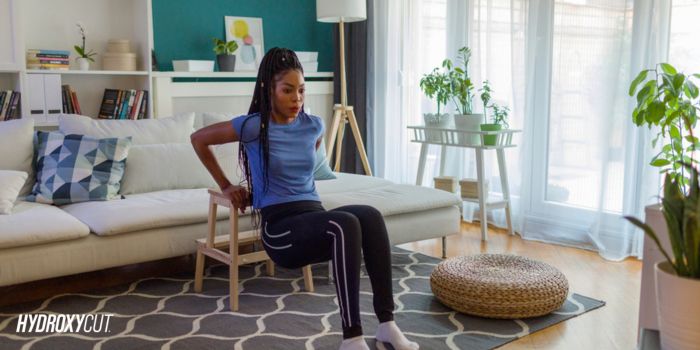Getting in shape and losing weight doesn’t require you to sign up for a 2-hour-a-day workout session at your local gym. In fact, it may not even require you to get a gym membership at all. While there are advantages to exercising at a gym, sometimes it’s just not possible to get to one.
Not having a gym or gym equipment handy doesn’t mean your results should suffer. We’ve put together a 30-minute workout that you can do at home, in a hotel room, or anywhere you happen to be. All you need is your body, a watch, and around 30 minutes.
Table of content
The bodyweight exercises
Exercises are kept to a minimum so you can easily master them and do them on a circuit. These exercises are not easy, but they’re fun and they’ll get your heart rate going while helping you target all the key muscles in your body.
1. The burpee
Burpees are arguably the toughest exercise you can do with no equipment. Yet as with everything that takes effort, the results you’ll see on your body will make the challenge worthwhile! In a nutshell, burpees burn calories and offer benefits to more than just your cardiovascular system, they also to many of your key muscle groups!
If you master just one exercise in this workout, make it the burpee and you’ll be well on your way to a slimmer you.
To do a burpee, stand tall with your feet together. Come into a low squat and place your hands on the ground. Then jump your feet back to bring your body into a push-up position.
Hop your feet back toward your hands and explode into the air, jumping as you reach your arms above your head to gain height. Land and repeat.

2. The push-up
Push-ups are a staple bodyweight exercise and are part of the Army’s basic training physical fitness test because of their effectiveness at toning your chest, shoulders, and triceps (back of your upper arms). They also engage your abs and your legs.
To do a push-up, start by kneeling. Bring your hands down to the floor, about shoulder-width apart. Press down on your hands and bring your legs behind you, propping yourself up on your toes. Straighten your back until it is parallel with the floor. Then lower your body down slowly until your elbows are at a 90° angle. Push back up slowly and return to the starting position.
Tip: If you’re having trouble doing traditional push-ups, you can do them at an angle against a table, couch, weight bench, bed, or counter. The object should be around knee-to-waste-height. Stand back far enough so that you can lean your body diagonally against the object, holding yourself up with your arms.
Bring your chest down to the bench or whatever you are practicing on, and focus on keeping your body in a straight line, from your ankles to your hips to your shoulders. Do the push-ups at this level until you develop enough strength to do them on the floor.
3. The glute bridge
This is a great exercise that targets your butt and abs at the same time!
To perform the glute bridge, lie on your back with your knees bent and your feet flat on the floor. Place your arms at your sides with your palms facing down.
Now, squeeze your glutes and slowly raise your butt off the floor until your body forms a straight line from your knees to your shoulders. Hold this position for 3 to 5 seconds (this is key), then slowly lower yourself to the floor. This counts as 1 rep.
4. The jump squats
Jump squats are a plyometric exercise that gets your heart rate up and helps to tone your quads (front of your leg), hamstrings (back of your thigh), butt, and calves.
To do a jump squat, interlace your fingers behind your head and pull your elbows back so that they’re in line with your body. Bend your knees in preparation to leap and then explosively jump as high as you can. As you land, immediately go into a squat and then jump again.

5. The plank
The plank is a great exercise for developing core strength, and it can be done anywhere! They works the abs and lower back, while also targeting the quads and the butt.
To perform the plank, start to get into a push-up position, but bend your elbows and rest your weight on your forearms (instead of resting your weight your hands). When you’re in the proper position, your body should form a straight line from your shoulders all the way to your ankles. The key to holding this straight line is to brace your core by contracting your abs as if you were protecting yourself from a punch to the stomach. Don’t hold your breath though you need to breathe slowly and deeply. Hold this position for 30 seconds or as long as you can.
The 30 minute bodyweight workout routine
This routine will be a circuit. The key with this circuit is to rest minimally between exercises to keep your heart rate up. To keep the routine to 30 minutes or less we recommend you rest 30 seconds between exercises and 2 minutes between circuits, but you may find this rest time is too short at first. If that’s the case, you may add time between circuits to recover.
Avoid resting too long between exercises. Remember that some exercises, such as burpees, will be more taxing, while others, such as glute bridges, will allow you to catch your breath a little as you squeeze the slow, controlled reps.
FAQs on Bodyweight Workouts
Can Bodyweight Workouts Build Muscle?
Absolutely! Bodyweight exercises are an efficient and valuable addition to your workout regimen, as noted by the Mayo Clinic. They enable a comprehensive range of motion and foster a stronger mind-muscle connection, ensuring each muscle group is engaged effectively and thoroughly.
What Are The Best Bodyweight Exercises To Build Strength?
In designing your full-body workout routines, prioritize incorporating functional, compound movements that target the lower body, upper body, and core simultaneously. Your go-to bodyweight exercises, such as push-ups, squats, and planks, are key components of a good workout plan to build strength.
How long should bodyweight workouts be?
The duration of bodyweight workouts can vary based on your fitness level, goals, and the intensity of the exercise routine. However, a general guideline is to aim for 20 to 60 minutes per session. For beginners, starting with shorter sessions (20-30 minutes) and gradually increasing the duration as you become more comfortable with the exercises is beneficial. For those with more experience or looking to achieve specific fitness goals, longer sessions (up to 60 minutes) might be more effective.
Shop America's Best Selling Weight Loss Supplements
Some links used in this article are being provided as a convenience and for informational purposes only; they do not constitute an endorsement or an approval by Iovate Health Sciences International Inc. or any of its affiliates (“Iovate”) of any of the products, services or opinions of the corporation or organization or individual. Iovate bears no responsibility for the accuracy, legality or content of the external site or for that of subsequent links. Contact the external site for answers to questions regarding its content.




